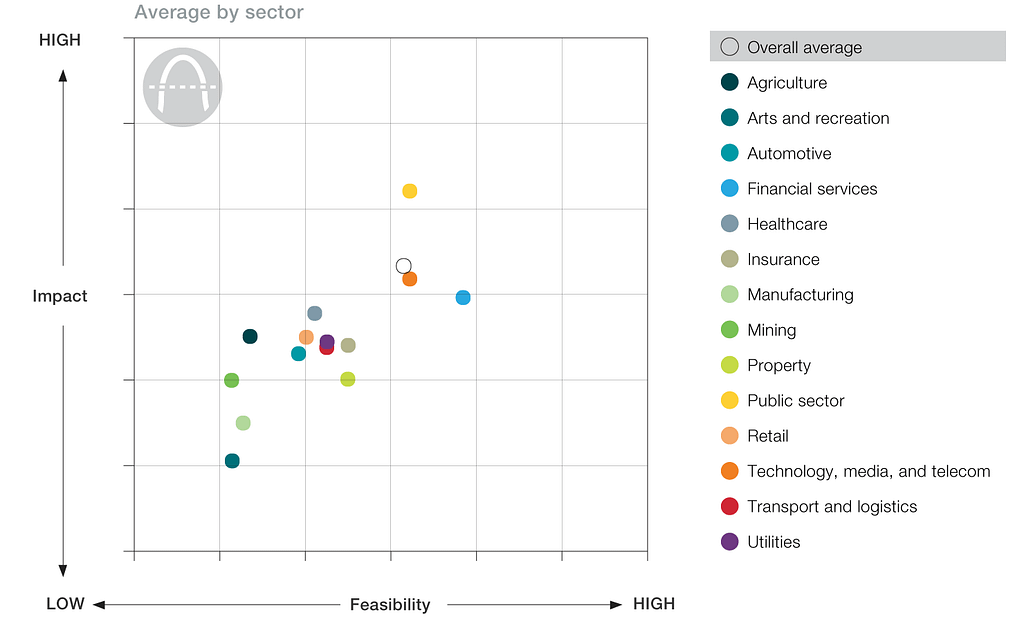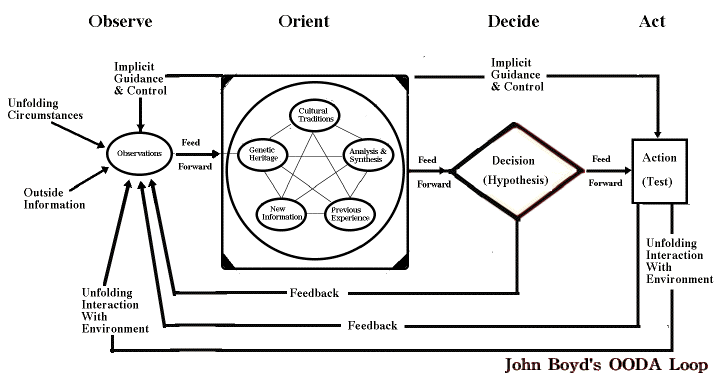Latest news about Bitcoin and all cryptocurrencies. Your daily crypto news habit.
I recently came across this new McKinsey report which measures the “strategic value” of blockchain and distributed ledger technologies.
I didn’t hate it. The report adequately explained blockchain, debunked a few common myths, and presented a not-unproductive framework for blockchain use cases. As a former consultant at Bain, I dig these sort of reports.
But then I got to the 2x2 matrix — a classic consulting tool typically used to help companies navigate a sea of strategic opportunities. The matrix grades both industries and industry-specific use cases by scoring the potential impact of blockchain as well as the feasibility of realizing that potential. While such a tool is easy on the eyes, I suspect that it is far from accurate.
 McKinsey prioritization framework for blockchain
McKinsey prioritization framework for blockchain
‘Legacy’ strategy doesn’t work on the leading edge
Why do I feel so confident the above matrix is wrong? Just look back at management consulting’s futile attempts to contextualize other major shifts in technology and business. The classic example is McKinsey’s prediction that cell phone sales would max out at 900K units…whoops! Having myself consulted Silicon Valley tech giants on major internet trends a few years ago, I can guarantee firsthand that the cell phone blunder was not a one-off.
This article is not a smack down of management consulting — for that, see this article and this article ;) As a former consultant, I respect the craft and believe the tools, frameworks, and often brilliant talent generates value in more stable markets. But the strategy toolkit developed in business schools a hundred years ago and refined at top consulting shops is simply not cut out for the modern technological era, one of high uncertainty and rapid change.
‘Legacy’ strategy is too slow and too rigid
Strategists setting out to understand a new industry typically develop a thorough and detailed 100+ slide factbase, complete with market sizing, value chains, frameworks, expert interviews, predictions, and all forms of analyses. Once completed, consultants are paid to defend their work with zeal as the “single source of truth.”
While such endeavors look impressive, these efforts tend to be misguided in nascent and rapidly changing industries. The two primary reasons are that:
- This work takes too long to complete.
- Most of the output is not that useful.
Traditional strategic analysis is too slow for high growth industries
By the time strategists draw conclusions, the presented point of view tends to be outdated. The ‘waterfall’ approach to strategic analysis is poorly equipped to reflect real-time changes in market conditions.
Output from such work is not that useful
In high uncertainty environments — like the birth of the internet or blockchain — the error bars on future state predictions are high:
- Markets might grow a factor of 10x or 1000x (e.g. crypto, 2017)
- Leading competitors can drop out or disappear (remember Sidecar?)
- Promising use cases might be duds or superseded by killer apps (e.g. web portals => search)
- Value pools rapidly shift, and new business models emerge. For example, artists and labels lost their grip on the music industry value pool, first to iTunes’ track-level “transactional” purchasing model then to subscription-based streaming services.
At ConsenSys, we have no shame in admitting that we can’t predict where Web 3.0 is headed. On “The Blockchain and Us” podcast, our head chef of ConsenSys — Joseph Lubin — doubled down on this idea:
We don’t really know what is going to be constructed by creative people ten or so years from now... If you look at how web technology ramified between 1989, when it was invented, and 1999, when normal human being were using email, I guess you could have extrapolated from there, but you couldn’t extrapolate to people sending 140 character messages, dating online, getting into a stranger’s car, or sleeping in a stranger’s home, where these would be common mechanisms in society in a couple of decades.
Even for forward-thinking strategists, the error bars on future state predictions are often massive. And so declarations of market “facts” tend to be fleeting at best.
Together, both shortcomings produce non-optimal solutions
Clinging to the above approach, old school strategists notoriously solve for local maxima. Well understood and immediately actionable opportunities might be marked as high priority while more nebulous, technically complex opportunities will be de-prioritized. For example, consulting shops were woefully inadequate at predicting the rise of search, mobile, social media, video streaming, and cloud computing, to name a few.
Now let’s be clear: It is absolutely critical to establish a solid foundation of industry knowledge in order to make firm strategic decisions. But my observation is that — in the start-up context — the most successful strategists dismiss the slow, methodological, and static nature of traditional corporate strategy functions. Instead, a Lean approach — paired with agile working styles and a Sprint methodology — provides a superior approach to strategic decision making in high-growth tech environments.
“Lean Strategy,” in Short
While the lean start-up was proposed by Eric Reis for product development, the principles are broadly applicable for shaping businesses and doing strategy. Steps in Lean Strategy:
- Identify testable hypothesis: Quickly develop a preliminary view of the market and potential opportunities. While it’s worthwhile to take a day to prioritize the opportunities with whatever facts you have, its more critical to articulate the underlying assumptions: what would need to be true in order for an opportunity to reach its full potential?
- Take hypotheses to the market early and often: Share hypotheses with experts, potential clients, other entrepreneurs, and the venture community. Solicit feedback and pressure test critical assumptions. Note that, by necessity, there will be bugs in the output, gaps in the thinking, and errors in the analysis. However, the early and frequent feedback loops will be greatly more valuable than the alternative (i.e. buttoned up but likely wrong output.)
- Develop feedback loops: Feedback is great, but incorporating it into the point of view can be intellectually and emotionally challenging. Use every new data point to revisit core assumptions and “smash idols.”
- Rapid iteration: Rinse and repeat the above as often as humanly possible.
I’ve heard Reid Hoffman refer to this process as an OODA loop.
OODA stands for Observe, Orient, Decide, and Act. Reid should also add an “F” for feedback, as it is a critical part of the system. The more frequently and quickly tech leaders can OODA(-F) loop, the more likely they are to succeed.
This approach is tough, and it is scary. Lean Strategy requires its participants to avoid confirmation bias, analysis paralysis, and intellectual defensiveness. Lean requires more work but less waste. Lean means failing frequently in the early stages, all to avoid a more critical failure under a waterfall model. It also means being less focused on output and more focused on the outcome one is striving to achieve.
Trade offs
The Lean approach clearly comes with a set of trade-offs. There will be gaps in our knowledge base, assumptions proven wrong, and some errors from moving fast. But “move fast and break things” is an inherent part of the Lean Strategy process. Embracing it will require all stakeholders to understand the approach and commit to the process.
In addition, the work a Lean Strategy team produces will be a starting point, not an end state point of view. As described above, I believe that this approach works better than legacy strategy in high uncertainty, rapidly changing environments where success is measured by responsiveness to feedback, agility, and creativity.
Conclusion
Lean strategy works in Silicon Valley, but like any set of tools, its deployment must be custom-tailored to the environmental context and team personality.
Winning in yet-to-be-defined markets requires thinking different. At ConsenSys Labs, we’re challenging our incubated projects, Enterprise partners, and industry stakeholders to think differently every day.
Try it yourself, and let me know what works and what doesn’t.
Hit me up on Twitter to hear how Lean is working for ConsenSys Labs
Lean Strategy for Web 3.0 was originally published in Hacker Noon on Medium, where people are continuing the conversation by highlighting and responding to this story.
Disclaimer
The views and opinions expressed in this article are solely those of the authors and do not reflect the views of Bitcoin Insider. Every investment and trading move involves risk - this is especially true for cryptocurrencies given their volatility. We strongly advise our readers to conduct their own research when making a decision.
